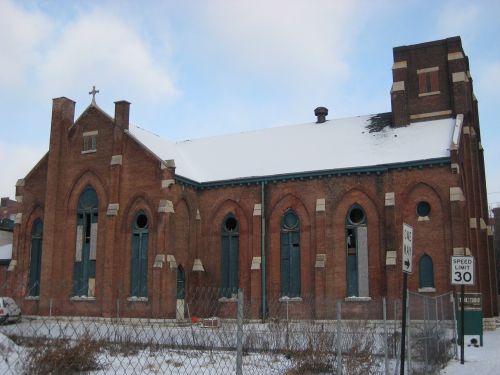 As likely is the case in most communities around the country, there are abandoned churches in neighborhoods that used to be vibrant and alive. I know this is true in my neighborhood (I can see the abandoned church pictured in this post from my window) and I have seen it in other cities, particularly off the coasts where there is plenty of cheap land and the geographic cores of cities have gone through a several-decades long transformation from life to death.
The abandoned church buildings are the tip of the iceberg of a huge story that encompasses religion, culture, family life and politics. Part of that story was told Saturday in The Chicago Tribune in a special by Jeffrey Steele, who describes how abandoned churches are being converted into fancy condo buildings for the new generation of downtown city dwellers:
As likely is the case in most communities around the country, there are abandoned churches in neighborhoods that used to be vibrant and alive. I know this is true in my neighborhood (I can see the abandoned church pictured in this post from my window) and I have seen it in other cities, particularly off the coasts where there is plenty of cheap land and the geographic cores of cities have gone through a several-decades long transformation from life to death.
The abandoned church buildings are the tip of the iceberg of a huge story that encompasses religion, culture, family life and politics. Part of that story was told Saturday in The Chicago Tribune in a special by Jeffrey Steele, who describes how abandoned churches are being converted into fancy condo buildings for the new generation of downtown city dwellers:
From near-in city neighborhoods to outlying suburbs, shifting population patterns and evolving congregations are resulting in older churches becoming available for other uses.
The most successful conversions are those overseen by developers who, by retaining important elements of the former church, give new meaning to the term "faithful preservation."
The story appears in the Tribune's classified section, and from a real estate perspective it is quite good. But I am not sure that the author thought of the religious aspects in the story because many religion ghosts go undiscussed.
One subject that was mentioned briefly in an off-handed manner is the sacred nature of these church buildings. Certainly zoning regulations played a factor in these developers' plans to transform places of worship into fancy living spaces, but the primary consideration towards the spiritual seemed focused on the aesthetic:
A very different kind of church-to-residence conversion was finished this summer in LaGrange, where developer Hazel Teichen transformed the former Grace and Truth Life Church at the corner of Ogden and Kensington Avenues into a single-family home.
According to Susan Breen, real estate broker with the Hinsdale office of Coldwell Banker, the house of worship had been a Swedish Covenant church when built in the 1880s. It is noted in the National Register of Historic Places.
Built of Chicago common red brick and featuring 15 gothic arched windows, the structure boasts a ceiling comprised of scissored joists beneath a vaulted roof, Breen said.
The flooring in the foyer area is of reclaimed Jerusalem Bible stone, and the original sanctuary area has a Douglas fir floor, she added.
Teichen purchased the church in July of 2005, when its congregation numbered just eight people.
"I wanted to retain the spiritual integrity of the building," she said. "I didn't want people to come in and say, 'What did it used to be?' If it looked just like any other building down the block, what would be the point?
"I like to think of it still as a sacred place, with 100 years of sacred practice. You don't disregard that."
Another angle that could be explored and is probably more fitting for a separate story is the history of these church buildings. The article discusses an old Ukrainian Village Catholic church, Our Lady of Good Counsel Catholic Church, a Bohemian Catholic church building Our Lady of Good Counsel, a Swedish Covenant church on the National Register of Historic Places, Grace and Truth Life Church and a 100-plus year-old an African-American Baptist church.
What are the stories behind these church buildings? Why are there no longer congregations worshiping once a week in that building? What happened to the community life that supported these structures? What a fascinating way to explore and explain the changing communities in American cities.
Photo taken by the author of this post Tuesday morning in a near northeast side Indianapolis neighborhood.
